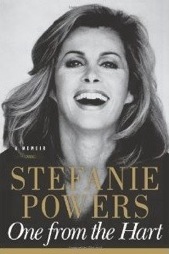ONE FROM THE HART
By Stefanie Powers
Simon & Schuster (2010). 257 pages. $26
PIECES OF MY HEART
By Robert J. Wagner with Scott Eyman
HarperCollins Publishers (2008). 324 pages. $25.95
We dip into these actors’ memoirs as a service to FYEO readers who might think, with some justification, that these books will offer an inside look at the authors’ famous 1960s spy series, The Girl From U.N.C.L.E. and It Takes a Thief. Our advice is to save your time and money.
Stefanie Powers recounts her life as a Hollywood kid with a devoted, ex-chorus girl mother and a vanished father, who, like many performers of her era, got her start in pictures but gained fame and fortune on television. But she leaves out quite a bit along the way.
Powers seems to have forgotten that she even did TV in the early 60s — guest shots on The Ann Sothern Show, Bat Masterson, Bonanza, Route 66 and the like — and that she made many of these early appearances under the risible stage name of Taffy Paul. How in the world did she come up with that one? Well, you won’t find out here. Or even where she got the more famous Stefanie Powers moniker. That probably came from Columbia Studios, where she was a contract player in the days when actresses didn’t even try to launch screen careers under their real names, if their real names were anything like Stefania Zofja Federkievicz. Columbia put her, once suitably renamed, into “The Interns” and “Experiment in Terror,” and loaned her out for such fluff as “Tammy Tell Me True,” “Palm Springs Weekend” and “McLintock.”
Powers doesn’t mention television at all until MGM is suddenly buying out her Columbia contract in 1966 so she can star in The Girl From U.N.C.L.E. Further unmentioned is the fact that Metro was forced into that deal because NBC was so keen on having U.N.C.L.E. agent April Dancer embodied by Powers and not by Mary Ann Mobley, the actress cast by the U.N.C.L.E. producers in the pilot for a series they didn’t really want to make. After The Man From U.N.C.L.E. became a phenomenal hit, network programmers insisted that a spin-off with a female agent would be a terrific idea — but only with Powers as the star.
Who at NBC was pushing so hard for Powers? And why? Don’t ask her — The Girl From U.N.C.L.E. is dispensed with in less than two pages, and the only U.N.C.L.E. story Powers can come up with is the remarkable claim that no less than Katharine Hepburn approached her on the MGM lot one day to tell her that “Spencer and I watch your program all the time.”
The second of her three TV series also goes completely unmentioned. Granted, The Feather and Father Gang ran for only six months in 1977, and it was just one of several “con” series that aired in the wake of “The Sting” (Robert Wagner’s Switch was another). But it also was quite arguably the best of her three series, and Powers was never better than when she was playing off the marvelous Harold Gould as her con-man father.
Surprisingly, Powers doesn’t even have much to say about her big hit Hart to Hart, another trashy, glossy success for ABC and Spelling-Goldberg, the company that provided an alarmingly large portion of ABC’s 1970s and 80s lineup. No, there’s really just one thing she wants to talk about at length.
Around 1974 (the book also is not very clear about numerous dates), Powers met the love of her life, film star William Holden, and that is the overarching story here. They were together for a decade or so, during which Holden’s alcoholism finally got the best of him. He died in a drunken stupor, hitting his head and bleeding to death before anyone found him. She’s supported Africa’s William Holden Wildlife Foundation in his memory ever since.
Readers interested in a tragic show-biz love story can revel in that, but anything about Powers’ career takes second place. And after Holden’s death and Hart to Hart’s cancellation, the career slowed down and the book gets to be even more of a slog. The odd gaps and abrupt transitions found throughout suggest that Powers turned in a longer manuscript and was ordered to cut it — and what was cut may well have been more interesting to us.
Robert Wagner was also a Hollywood kid after his family moved to Southern California when “RJ,” as everyone calls him, was seven. He grew up visiting Edgar Rice Burroughs at his Tarzana ranch and caddying at the Bel-Air Country Club for such celebrity golfers as Cary Grant, Clark Gable, Fred Astaire, Randolph Scott and Bing Crosby. Naturally, the good-looking, starry-eyed kid decided to go into show business.
Wagner apparently knew everyone in the industry in the 1950s, 60s, 70s and 80s, and his account of his personal and professional run-ins with these characters is far more entertaining than Powers’ similar stories (no doubt due to his credited co-writer). One of his earliest friends was Cubby Broccoli, who was a talent agent way back when, working for Charles Feldman’s Famous Artists agency. Wagner claims that, 25 years later, Cubby offered him the James Bond role when George Lazenby walked out after “On Her Majesty’s Secret Service” — but RJ insisted that Bond should be British and recommended his old friend Roger Moore for the part (Wagner doesn’t mention that Cubby obviously ignored his advice, first hiring American actor John Gavin to play Bond in “Diamonds Are Forever,” and then dumping him when United Artists lured Sean Connery back).
It Takes a Thief was the last of the great 60s spy shows, and Wagner’s first TV series after two decades in pictures. He devotes an entire, albeit brief, chapter to the show but still manages to reveal absolutely nothing of real interest. Universal was cheap — well that’s a real surprise. Wagner’s example: the studio didn’t like his suggestion to hire Fred Astaire to play his father, fearing Astaire would demand too much money. Wagner says he decided to vanish for a few days, shutting down production until studio execs came around.
Maybe that really happened. Maybe not, since Wagner also gives the strong impression that Astaire was part of the entire run of It Takes a Thief when he actually appeared in just four episodes in the third season. But Wagner also leaves readers with the idea that he was perfectly happy and successful doing movies until Universal chief Lew Wasserman waved the Thief pilot and a great percentage deal in front of him. In fact, he was having the same problems getting good film roles in the 1960s that other second-tier leading men of the 1950s were having, and he had prudently started making TV pilots as early as 1964. It Takes a Thief was the first one that sold.
Ten years later, after three seasons of Thief and three in Switch, Aaron Spelling and Leonard Goldberg asked him to read Sidney Sheldon’s original version of Hart to Hart. Wagner says he turned it down flat because it was a tasteless, tacky spy story in the vein of the Matt Helm movies. When Spelling asked what he’d rather do, Wagner not only takes credit for suggesting a “Thin Man” knockoff but also for recommending that Tom Mankiewicz be hired to write it.
From that simple idea, everyone involved made a fortune during Hart to Hart’s inexplicably lengthy five-year run, but the series as revamped by Mankiewicz certainly was no improvement on tacky Matt Helm spy stories. Watch any episode of Remington Steele to see how it should be done — or better yet, any of the “Thin Man” movies Wagner wanted to emulate. It’s a genuine shame that Wagner and Powers both will be best remembered for Hart to Hart, a series so totally, contemptibly phony in every way that it was nearly unwatchable to anyone weaned on TV’s earlier, vastly superior adventure shows.
Performers are entitled and expected to tell their stories their way, but it’s awfully irritating how short on real information both these books are. Roger Moore’s and Robert Vaughn’s remain the best of the recent flurry of actor memoirs.





